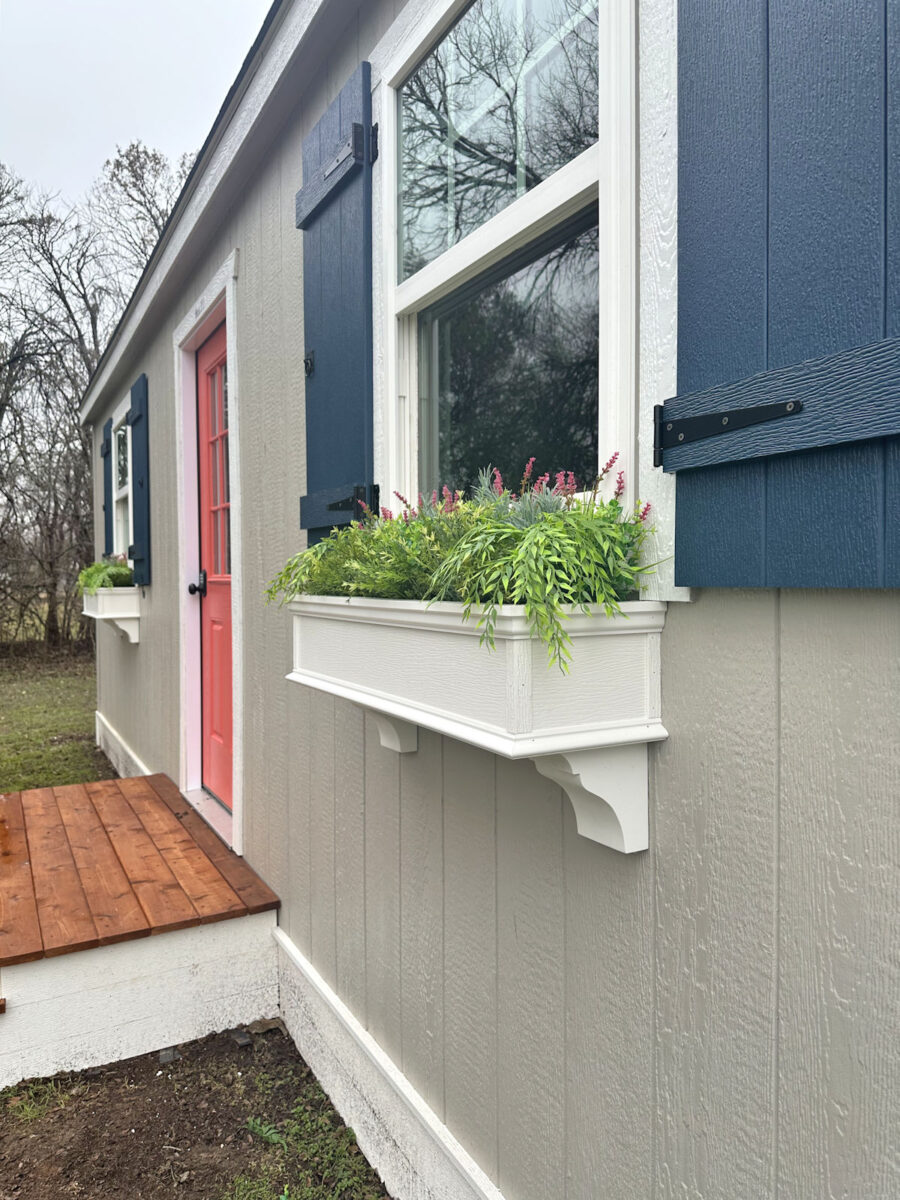
My DIY window packing containers for the workshop are achieved! Y’all, this is likely to be my favourite undertaking but. I imply, I understand that each one of those initiatives are working collectively to create the look I needed. Had I simply plopped some window packing containers onto this workshop in its authentic state and referred to as it good, they wouldn’t have achieved a lot for the constructing on their very own. However of all of the modifications I’ve made to date, that is the one I used to be essentially the most enthusiastic about. Simply look how cute these are.
And I’ll admit that I stuffed them with pretend vegetation…for now. I needed to see what they appear to be stuffed, but it surely’s winter. And sure, although I’m in central Texas, we do nonetheless type of have a winter. It’s been getting under freezing at night time, so I didn’t wish to purchase actual vegetation just for them to freeze to dying. So for now, the pretend vegetation will do. As soon as spring hits, my plan is to show these into self-watering planters and plant some actual vegetation in them.
So let me present you ways I constructed these DIY window flower packing containers. That is such a easy undertaking that just about anybody can do. You possibly can see all the course of right here:
To construct the fundamental field, I used 1″ x 8″ PVC boards. After measuring my window, which was 32 inches vast, and measuring the house between shutters, which was nearly 38 inches, I made a decision to construct these packing containers 34 inches vast to depart sufficient room for the trim that I might be including later. So for every field, I lower one backside piece to 32.5″, two finish items to 7.25″, and two items for the back and front to 34″.


Since these are PVC boards, I used PVC glue to stick the boards to one another and nailed the boards along with 16-gauge 1.5-inch nails. I began by attaching the ends to the underside piece.


And as soon as each ends have been hooked up, it seemed like this…


Then I positioned the underside/ends portion on its aspect, and put PVC glue on the perimeters of the underside/ends, after which put extra glue across the ends and backside of the entrance piece. When working with PVC glue, it’s a must to work shortly since you need the glue to be actually moist once you put the items collectively. And PVC glue dries pretty shortly.


As quickly as I utilized a liberal quantity of PVC glue to these areas, I put the entrance board in place and nailed it on all the best way across the sides and backside.


I repeated that course of for the again piece, after which I had a really primary, no frills, plain field.


I took these photos whereas engaged on the 2 packing containers for the again of the workshop, and when constructing these packing containers, I went forward and trimmed them out earlier than I hung the packing containers on the workshop. However for those who watch the video of the method, you’ll see that I hung the plain packing containers on the constructing after which trimmed them out. Each methods labored simply nice, however I believe I most popular hanging the plain packing containers first after which trimming them out. After all, that solely works for those who’re hanging your window packing containers on an simply accessible window. In case you’re making them for a excessive window, you’ll clearly need them to be fully completed earlier than hanging them.
First, I trimmed out the highest fringe of the field utilizing a PVC molding referred to as shingle molding. The supposed function of shingle molding is to be used on the fascia boards of a home slightly below the shingles. Nevertheless it’s such a reasonably molding that I exploit it as a multi-purpose trim.


Right here’s a more in-depth have a look at the shingle molding…


To connect the entire trim, I used PVC glue and adopted up with 18-gauge 1-inch nails. I solely utilized the trim to 3 of the 4 sides of the field since I wanted the again to be fully flat to suit towards the constructing. So utilizing my miter noticed, I lower the entrance piece mitered on each ends.


After which I lower the aspect items mitered on the entrance corners, and lower straight alongside the again edge the place it might meet the constructing. In case your mitered corners aren’t good, don’t fear about that. That’s what caulk and exterior wooden filler are for. 😀


Right here’s a have a look at the field with the highest trim hooked up. You possibly can already see how the trim actually attire up the plain field.


To trim out the underside fringe of the field, I used PVC base cap molding. The supposed function of base cap molding is to decorate up plain baseboards (i.e., to cap off plain baseboards), however once more, I discover myself utilizing base cap molding for as a common function trim as a result of it’s so versatile. Right here’s a more in-depth have a look at base cap molding…


Utilizing my miter noticed, I lower and utilized that molding to the field in the identical means I did the shingle molding across the high.


And with the bottom cap molding on, the field was actually beginning to appear to be a reasonably planter.


At this level, I made a decision to hold these packing containers on the constructing. And since I work alone, I needed to make this so simple as potential. I went forward and began three screws by the again of the field. I used three 3-inch exterior screws for this.


After which I held the field up in place and screwed into to the siding. This course of was extremely straightforward with the kind of siding I’ve on this constructing. When you’ve got stone, it’s going to take a bit extra work that may require a masonry drill bit and masonry screws. And in case you have lap siding, the field would possibly have to be shimmed to get it to hold straight somewhat than at an angle. You’ll must assess what you want to your specific scenario.


I purchased these earlier than I purchased my band noticed, so I had no selection however to purchase ready-made corbels. However in case you have a band noticed, you may design and lower your personal corbels. When you’ve got a band noticed, you may make your personal PVC corbels (or wooden corbels) by laminating layers of 1″ boards collectively for the thickness you need (mine are produced from 4 layers of 1″ PVC boards). Glue them collectively and clamp them securely till the glue is totally dry. After which lower your design with the band noticed. However since I didn’t have a band noticed on the time, I purchased ready-made corbels.
First, I positioned the corbel contained in the field and marked the width of the corbel with a pencil to find out the place the screws wanted to be positioned. After which I began 4 screws.


After which I used a liberal quantity of PVC glue on the highest of the corbel and the underside of the field, and held the corbel in place whereas screwing it to the field with these 4 screws I began contained in the field. And right here’s a have a look at the field with each corbels hooked up.


And at last, I needed to trim out the corners of the field in order that the lower edges of the 1″ x 6″ boards of the field didn’t present. I used some scrap 1″ x 2″ PVC boards that I had available, and I lower these down utilizing my miter noticed in order that I had skinny strips that have been 3/4″ vast and slightly below 1/4″ thick. In case you don’t have a desk noticed, you should buy skinny PVC lattice or display screen molding for this. And I hooked up these items vertically on the entrance corners and alongside the again the place the field met the constructing.


And with that, the field construct was achieved. I nonetheless have to caulk and paint (similar to the skirting and the entrance steps) however the climate hasn’t been cooperative these days. So I’ll want to attend till we now have just a few sunny and dry days to do all of my caulking and portray. However I’ll be portray all of it white anyway, so it received’t change the look a lot, if in any respect. However for now, I’m totally having fun with the look of my uncaulked, unpainted flower packing containers.


For now, I went forward and drilled two small drainage holes on the underside of every field. I’ll be capable to fill these holes fairly simply with caulk as soon as I get able to convert these packing containers to self-watering packing containers within the spring. However for now, with the entire rain in our forecast over the subsequent week (at the least), I didn’t need these filling up with rainwater.


I simply love how these turned out. I believe they’re the proper contact for my workshop, they usually add some a lot wanted dimension to the in any other case very flat constructing.


And whereas pretend vegetation aren’t supreme, I’m joyful to have them stuffed with one thing that offers some shade and curiosity to the packing containers.

I spent about $200 on pretend vegetation for 4 packing containers. I don’t suppose that’s too unhealthy. I plan to maintain them and use them every winter, if mandatory. I don’t need empty window packing containers. 😀 I exploit a mix of vegetation from Passion Foyer, which I bought throughout a 40% off sale, plus these from Amazon (all affiliate hyperlinks): pink flower stems, boxwood stems, and weeping willow stems. These are those I selected, however there are a ton of different choices from that firm on Amazon.


So, that’s it! One other undertaking marked off of my checklist for the yr. And I couldn’t be happier with how they turned out.


I did make 4 flower packing containers in order that the again home windows (the home windows which might be seen from the road) may look cute, too. However what a multitude this aspect appears like with that soiled skirting. However a bit a part of the answer for that drawback is within the works, and I’ll share that tomorrow.


For now, I simply attempt to look previous the dust and admire my cute little window packing containers. 😀


If you wish to sustain with my 2025 checklist of residence objectives (and my progress with hyperlinks to completed initiatives!) you may see that right here: 2025 Master List of Home Goals
Addicted 2 Adorning is the place I share my DIY and adorning journey as I transform and beautify the 1948 fixer higher that my husband, Matt, and I purchased in 2013. Matt has M.S. and is unable to do bodily work, so I do nearly all of the work on the home on my own. You can learn more about me here.







